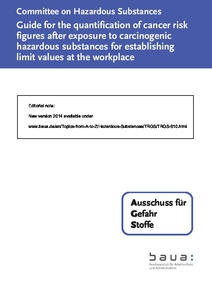Guide for the quantification of cancer risk figures after exposure to carcinogenic hazardous substances for establishing limit values at the workplace
"The present Guide is intended to provide the basis for describing exposure-risk relationships for carcinogenic substances according to harmonised regulations including the option of a scientific rationale for occupational exposure limits for these substances. For this purpose, criteria are est...
| Main Author: | |
|---|---|
| Institution: | ETUI-European Trade Union Institute |
| Format: | TEXT |
| Language: | English |
| Published: |
Dortmund
2008
BAuA |
| Subjects: | |
| Online Access: | https://www.labourline.org/KENTIKA-19287249124910054219-Guide-for-the-quantification-o.htm |
| _version_ | 1771659899470610433 |
|---|---|
| author | Committee on Hazardous Substances, Dortmund |
| author_facet | Committee on Hazardous Substances, Dortmund |
| collection | Library items |
| description | "The present Guide is intended to provide the basis for describing exposure-risk relationships for carcinogenic substances according to harmonised regulations including the option of a scientific rationale for occupational exposure limits for these substances. For this purpose, criteria are established to assess the suitability of available data on a substance and procedures are recommended to determine exposure-risk relationships from these data in the best possible way. The protection of workers from the risks related to exposure to carcinogenic chemicals (carcinogens) at the workplace is in particular regulated by EU Directive 2004/37/EC (Carcinogens Directive; EU, 2004) and the German Hazardous Substances Ordinance (GefStoffV; Bundesministerium für Arbeit und Soziales, 2005). Under the Carcinogens Directive, “carcinogen” is defined as a substance which meets the criteria for classification as a Category 1 or 2 carcinogen set out in Annex VI to Directive 67/548/EEC (EU, 2007). The same risk management is to be applied to substances of Categories 1 and 2 for carcinogenic substances (“carcinogens”) both within the meaning of the Carcinogens Directive and according to the GefStoffV. According to these provisions, it is thus irrelevant whether a substance was identified and classified as carcinogenic on the basis of epidemiological findings (Category 1) or of animal studies (Category 2)1 . Since cancer is considered to be a particularly severe disease and the Carcinogens Directive assumes that an exposure level below which no health hazard occurs cannot be determined, legislation provides for particularly far-reaching preventive measures for these substances." |
| format | TEXT |
| geographic | Germany |
| id | 19287249124910054219_e3e97370b33f4ed292379ddd2865f6f0 |
| institution | ETUI-European Trade Union Institute |
| is_hierarchy_id | 19287249124910054219_e3e97370b33f4ed292379ddd2865f6f0 |
| is_hierarchy_title | Guide for the quantification of cancer risk figures after exposure to carcinogenic hazardous substances for establishing limit values at the workplace |
| language | English |
| physical | 87 p. Paper Digital |
| publishDate | 2008 |
| publisher | Dortmund BAuA |
| spellingShingle | Committee on Hazardous Substances, Dortmund cancer determination of exposure limits risk assessment Guide for the quantification of cancer risk figures after exposure to carcinogenic hazardous substances for establishing limit values at the workplace |
| thumbnail | https://www.labourline.org/Image_prev.jpg?Archive=128321394650 |
| title | Guide for the quantification of cancer risk figures after exposure to carcinogenic hazardous substances for establishing limit values at the workplace |
| topic | cancer determination of exposure limits risk assessment |
| url | https://www.labourline.org/KENTIKA-19287249124910054219-Guide-for-the-quantification-o.htm |

